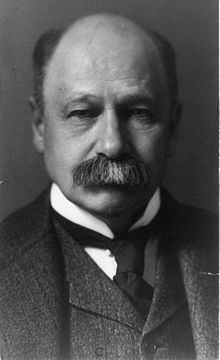Daniel S. Lamont
| Daniel Scott Lamont | |
|---|---|

Daniel S. Lamont in 1904.
|
|
| 39th United States Secretary of War | |
|
In office March 5, 1893 – March 4, 1897 |
|
| President | Grover Cleveland |
| Preceded by | Stephen B. Elkins |
| Succeeded by | Russell A. Alger |
| Personal details | |
| Born |
February 9, 1851 McGrawville, New York, U.S. |
| Died | July 23, 1905 (aged 54) Millbrook, New York, U.S. |
| Resting place | Woodlawn Cemetery in Bronx, New York, U.S. |
| Political party | Democratic |
| Spouse(s) | Juliet Lamont |
| Parents | John B. Lamont Elizabeth Scott Lamont |
| Alma mater | Union College |
| Profession | Clerk, Politician, Railroad Vice President |
Daniel Scott Lamont (February 9, 1851 – July 23, 1905) was the United States Secretary of War during Grover Cleveland's second term.
Daniel Scott Lamont was born on his family’s farm in McGrawville, New York, to son of John B. Lamont and Elizabeth (née Scott) Lamont. He attended from Union College at Schenectady, New York. While attending Union College, he joined from the Delta Upsilon Fraternity. Lamont was married to Julia Kinney, and have two daughters.
He was employed as engrossing clerk and assistant journal clerk in the state capitol at Albany, New York, was a clerk on the staff of the Democratic state central committee in 1872, and was chief clerk of the New York department of state from 1875 to 1882.
In 1883, through his mentor Daniel Manning, Lamont was assigned to then-New York Governor Grover Cleveland's staff as a political prompter. He became private and military secretary with the honorary rank of colonel on the governor’s staff the same year, and continued in his service after Cleveland became president in 1885. Lamont also held employment with William C. Whitney in his business ventures in 1889.
From March 5, 1893 to March 5, 1897, Lamont was served as United States Secretary of War in President Cleveland's cabinet. Throughout his tenure, he urged the adoption of a three-battalion infantry regiment as a part of a general modernization and strengthening of the Army. Furthermore, Lamont recommended the construction of a central hall of records to house Army archives, and urged that Congress authorize the marking of important battlefields in the manner adopted for Antietam. He also recommended that lands being used by Apache prisoners at Fort Sill be acquired for their permanent use and their prisoner status be terminated.
...
Wikipedia
